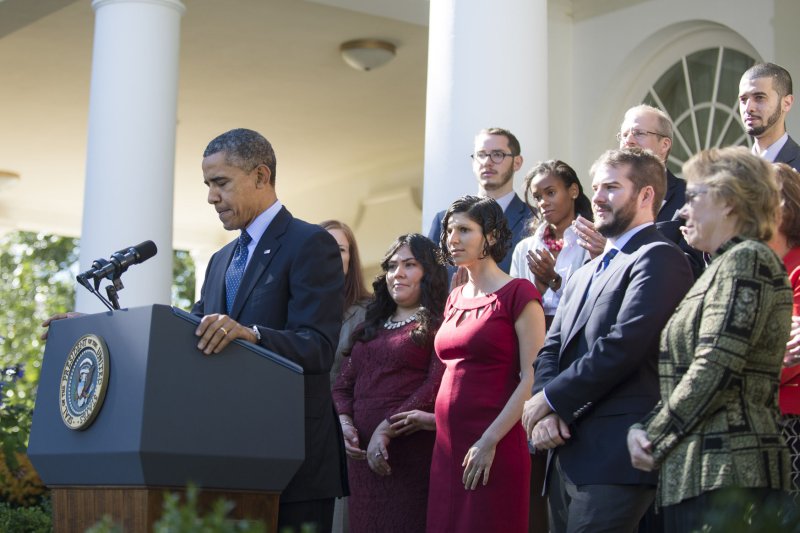President Barack Obama delivers remarks on Affordable Care Act in the Rose Garden at the White House on October 21, 2013. Obama, who was joined by Affordable Care Act supporters, acknowledge the problems with the website and promised fixes would be made quickly. UPI/Kevin Dietsch |
License Photo
WASHINGTON, Oct. 24 (UPI) -- Republicans railed against healthcare.gov and its rollout problems as Democrats highlighted efforts to fix the glitches at a U.S. House hearing Thursday.
At the House Energy and Commerce Committee hearing lawmakers staked out partisan positions, with Republicans expressing outrage at website defects and criticizing privacy and security considerations, as well as the lack of adequate testing, while Democrats emphasized programmers have fixed many of the problems and expanded the site's capacity.
Ranking Democrat Henry Waxman of California accused Republican colleagues of actively working to destroy the Affordable Care Act rather than working with Democrats to make the law work better.
He said rather than trying to fix it, Republicans are trying to "nix" it.
"The Republicans don't have clean hands coming here," Rep. Frank Pallone, D-N.J., said in his opening statement. "Their effort is obviously not to make this better, but to use the website glitches as an excuse to defund or repeal ObamaCare."
Democrats noted the exchanges being run by states are working much better than the federal site, on which 36 states are depending.
"The denial of this debacle is incredible," said Rep. Cory Gardner, R-Colo., who said he was unable to register for insurance.
Thirty-two Republicans have sent a letter to President Barack Obama, urging him to fire Health and Human Services Secretary Kathleen Sebelius because of the botched rollout.
Witnesses told the panel many of the problems experienced in the opening days of the health insurance exchanges have been corrected.
Andrew Slavitt of Quality Software Services Inc. said the capacity of the registration tool was doubled within seven days of rollout and Cheryl Campbell of GCI Federal Inc., a division of GCI Group Inc. of Canada, said the system currently is working and will continue to improve.
Slavitt testified the system "did not receive adequate end-to-end testing."
The witnesses testified it was the decision of the Center for Medicare and Medicaid to take the system live with only two weeks of testing, despite last-minute changes, including a decision to eliminate the anonymous shopping feature.
The administration Wednesday decided to extend the deadline for signing up for coverage to March 31 without facing a tax penalty.
A health plan purchased March 31 would likely start May 1, given that insurance plans typically start the first of the month and carriers usually require applications to be submitted no later than 10 days to two before a given month starts.
The law originally required people to be covered by March 31, not just purchase the coverage by that date, the White House said, which meant shoppers would have had to buy their plans by mid-February to avoid the fine.
Administration officials told The Washington Post the adjusted deadline was simply to clear up confusion and had nothing to do with the many technical problems plaguing the federal healthcare.gov website since it went live Oct. 1.
The federal website -- for residents of the 36 states that chose not to create their own state exchanges -- has had serious technological problems from its debut, making it difficult for individuals and small businesses to sign up for health insurance.
Campbell, in written testimony submitted to the panel in advance of the hearing, said her firm accepted partial blame for the site's shortcomings. But she said CMS was the "ultimate responsible party for the end-to-end performance" of the site.
She blamed user-verification software produced by QSSI for creating "a bottleneck that prevented the vast majority of users from accessing" the exchange.
QSSI parent UnitedHealth Group Inc. responded with a counter-statement.
"There are a number of other components to the registration system, all of which must work together seamlessly to ensure registration," the statement said. "The [QSSI-built] tool has been working well for weeks."
CGI Federal and QSSI were among the vendors whose executives told the committee Sept. 10 everything was going smoothly and the website would be ready Oct. 1.















